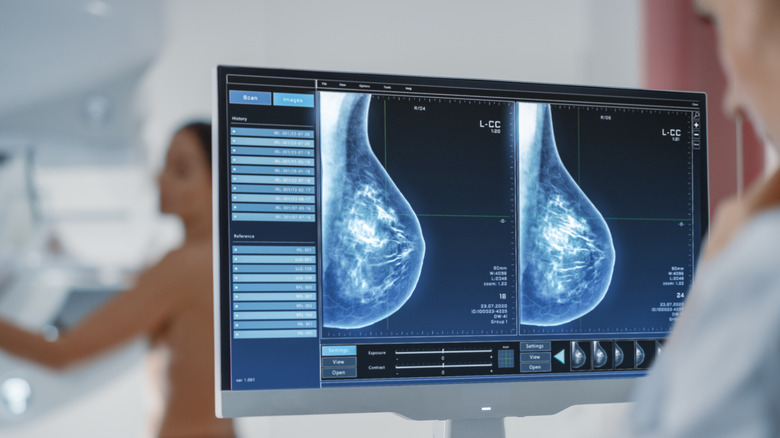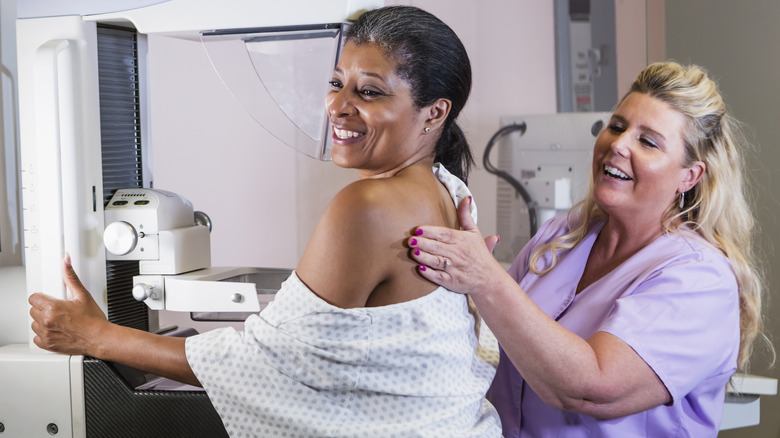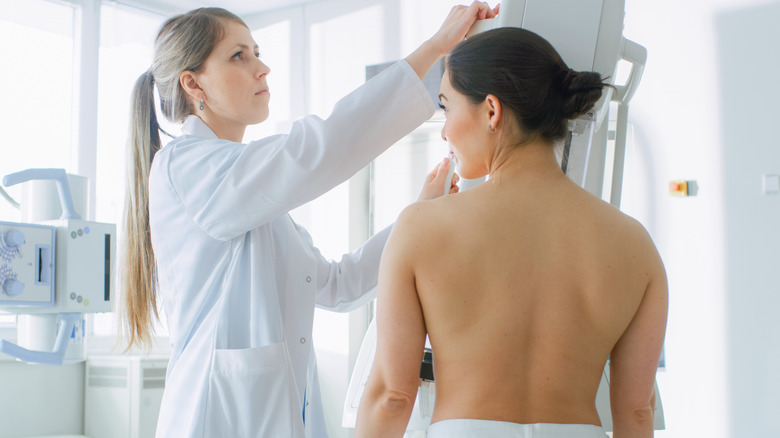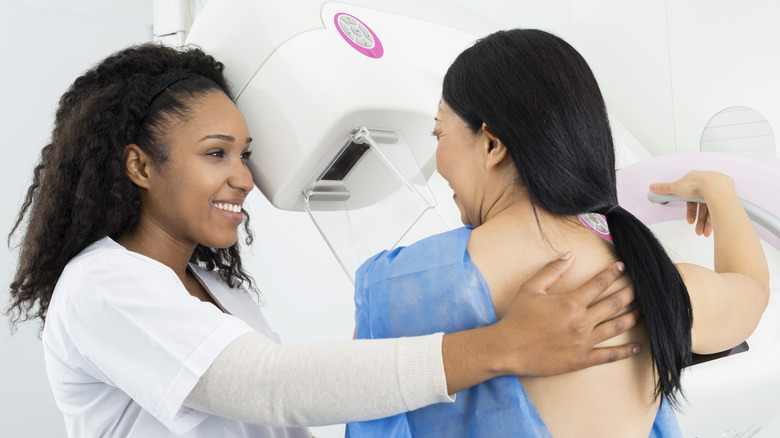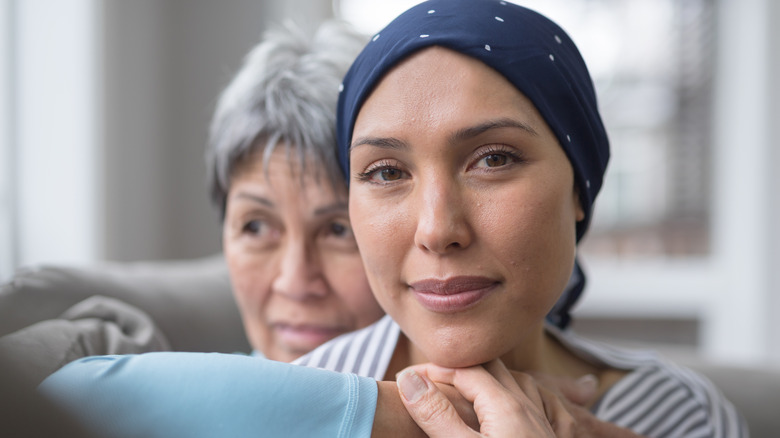We've Got The Answers To All Your Burning Mammogram Questions
Although we're all familiar with the word mammogram, it doesn't mean we all know exactly what it is. Often thought of as the type of screening that only middle-aged women should be concerned with, mammograms are actually important for more than just the 45+ crowd, especially if there's a history of cancer in the family. In other words, the old standards for mammograms are changing and we all need to get on board with the new narrative.
According to the American Cancer Society, breast cancer is the second most common form of cancer for women in the United States — just behind skin cancer. Breast cancer accounts for 30% of all new cancer diagnoses in women every year, with 2023 projections estimating close to 300,000 new cases of invasive breast cancer and almost 44,000 deaths due to breast cancer. It's also been found that rates of breast cancer have increased every year by 0.5% and is second, only to lung cancer, in cancer-related deaths in women.
With numbers like this, it's important that we recognize not just the cancer, but the medical screening that can catch breast cancer early and help prevent more deaths from it. So drop what you're doing and pay attention. What you're about to read just might save your life.
What is a mammogram?
When it comes to breast cancer screening, mammograms are the most efficient way to get a clear image of the inside of the breast so as to weed out any possibility of cancer. Because of this, the U.S. Food and Drug Administration not only stays on top of mammography devices (X-ray machines), making sure they're all up to date and working within their guidelines, but the FDA also updates regulations surrounding these machines as well as who should be getting these screenings on a regular basis.
Mammograms are comprised of low-dose X-rays that can detect early signs of breast cancer that your doctor is unable to feel through breast examinations they do with their hands alone. The screening is performed by a mammographer who is specially trained in using the mammography system in order to get the clearest possible images that a radiologist will look at and examine afterward for any possible abnormalities.
What you can expect
Upon arriving in your health care provider's office, you'll be asked to remove your bra and shirt, and stand in front of the mammography machine. Each breast will be examined individually by being flattened between two plates — a necessary step to spread the tissue, making it easier to find possible tumors or other indications that might suggest cancer. Although we've all heard the stories about how much mammograms can hurt like heck because your breasts are essentially being squished into pancakes in order to be properly X-rayed, pain is subjective.
"Every woman is different but, in general, a mammogram shouldn't be painful," radiologist and medical director of breast imaging at Memorial Care Breast Center, Dr. Richard Reitherman told PopSugar. "There may be a second or two of discomfort when the breast is compressed, which only takes a few seconds, but that's it."
Granted, breast sensitivity changes with your menstrual cycle. So if your period is fairly regular, you might want to schedule your appointment at a time when your sensitivity is at its lowest. After the screening is complete, the technicians may ask you to wait a few minutes to make sure the X-rays are clear and don't need to be retaken. The entire procedure usually lasts about 15 minutes, then you're sent on your way.
How to prepare for a mammogram
In addition to scheduling a time when you're less likely to suffer discomfort from your menstrual cycle, there are certain things you want to avoid putting on your skin before heading out to your appointment. You definitely want to skip deodorants, lotions, creams, perfumes, powders, body oils — basically anything that you might usually put under your arms, and under or over your breasts. The reason for this is that these substances can contain metallic particles that may show up in your mammogram results, leading to confusion and the possibility of having to do another screening, via Mayo Clinic. Makeup is fine, as long as it's only on your face — you can save the shimmering breast sparkles for the weekend.
If it's your first mammogram and you are fearful of pain, or if you've had them before and you already know it's going to be an uncomfortable experience for you, then taking an OTC pain reliever like ibuprofen or something similar an hour before your screening can ease any possible pain-related problems.
Who should be getting mammograms
The general rule of thumb is women 45 to 54 should get a mammogram once a year, with women between 40 and 44 being allowed to start their screening earlier than recommended if they choose, according to the American Cancer Society. However, there are some exceptions to this. For example, if breast cancer runs in your family or you're aware that you carry a genetic mutation, mammograms can start as early as 25. According to Memorial Sloan Kettering Cancer Center, for those with breast cancer in their family history, it's suggested that mammograms should begin 10 years earlier than when the affected relative was diagnosed.
While we rarely, if ever, think of breast cancer as a young women's disease, it actually can be. According to a 2019 study published in Pediatric Blood & Cancer, among women between 15 and 39 years of age, breast cancer is the most common cancer, making up 5.6% of all invasive breast cancer found in women. That's why it's so important to know your family health history and start breast self-exams early. If you're not sure how to do it or what you should be looking for, ask your doctor to show you.
Women 55 and older can reduce their yearly mammograms to once every two years if they choose, or they can continue to do yearly for their own peace of mind.
Who pays for mammograms?
With all this information under your belt, you might be wondering exactly how much a mammogram is going to set you back. For the most part, mammograms are free — most insurance companies, as well as Medicare and Medicaid, cover the screening.
As of August 2012, The Affordable Care Act began requiring all new health insurance plans to not only cover mammograms but the co-pay for them as well. Although health insurance plans that existed before this are exempt from the requirement, under the ACA, this coverage is available for women over 50 who want mammograms every two years, and women between 40 and 49, if it's recommended by their doctor that they should be getting regular screenings. For those who don't have insurance, there are affordable mammogram options. The CDC's National Breast and Cervical Cancer Early Detection Program works with people to find either free or low-cost mammogram screenings.
The most important takeaway here is that breast cancer doesn't just happen to middle-aged women. It can happen to women of all ages and, as studies have found, to women as young as 15. Since this is the case, anyone with breasts who are concerned about a lump they found, their family history, or just want to get started early on their screening, shouldn't hesitate to talk with their doctor about their options.
